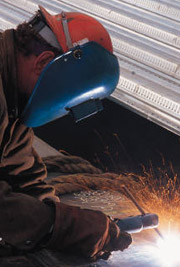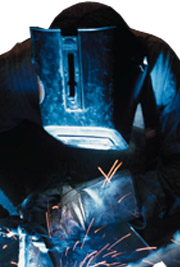Arc discharge and health
- What is arc discharge?
- Who is at risk of UV exposure from arc discharge?
- Laws and regulations controlling the use of arc welders
- Health risks associated with arc discharge
What is arc discharge?
Arc discharge is the discharge emitted from electric welding arcs. The exact levels of ultraviolet (UV) radiation produced by a welder depend on the length of exposure time, the type of current the welder uses, the shielding gas the welder uses and the type of metal being welded. The level of UV overexposure danger associated with various types of welding can be classified as follows:
- High: including gas metal arc welding and gas tungsten arc welding;
- Medium: most shielded metal arc welding;
- Low: submerged arc welding; or
- Minimal or nil: oxyacetylene welding, resistance welding, friction welding, friction stir welding.
Arc welding produces UV radiation at hazardous levels, from across the UV spectrum (i.e. UV-A rays with a wavelength of 400-315 nanometres, UV-B rays with a wavelength of 315-280 nanometres and UV-C rays with a wavelength of 280-100 nanometres).
The sun also produces UV rays in the A, B and C spectrums. UV-A rays account for some 98% of an individual’s solar UV exposure, however UV-B rays are responsible for much of the DNA damage which causes cancer.
UV-C rays from the sun are absorbed by the earth’s ozone layer and individuals are thus not exposed to solar UV-C. As such, little is known about the relative dangers of UV-C, compared to UV-A and UV-B. However, while it is likely that much of the UV-C emitted from welding arcs is absorbed into the immediate atmosphere, UVC from welding arcs may also come into contact with, and be absorbed by, an individual’s skin. This means that individuals in the close vicinity of arc discharge may still be exposed to arc generated UV-C. It is thought to be as dangerous to the skin as UV-B radiation.
Who is at risk of UV exposure from arc discharge?
 Individuals operating electric welding arcs are most at risk of UV exposure from them, as they are positioned very close to the source of UV rays (e.g. the face and hands of the operator is typically very close to the welding arc). As arc welders generate significant heat, users may feel uncomfortable wearing heavy protective clothing and gloves, and therefore be less likely to wear them, increasing their risk of UV exposure.
Individuals operating electric welding arcs are most at risk of UV exposure from them, as they are positioned very close to the source of UV rays (e.g. the face and hands of the operator is typically very close to the welding arc). As arc welders generate significant heat, users may feel uncomfortable wearing heavy protective clothing and gloves, and therefore be less likely to wear them, increasing their risk of UV exposure.
Welders’ assistants, for example, would hold pieces of metal in place in order that they can be welded, are often also in very close proximity to arc discharge and therefore at high risk of over-exposure to UV. Electric welding arcs also potentially create an exposure risk for individuals working in the direct environment of an arc welder (e.g. in the same factory) as well as onlookers or passers by.
Many individuals who use welding arcs are formally trained to do so. These individuals typically use arc welders frequently, in environments characterised by high levels of protection (e.g. face shields and gloves being worn). The limited available scientific evidence suggests that using an arc welder with adequate protection, as this group usually do, does not increase the risk of skin cancer.
However, many more individuals who are not trained as welders (e.g. those engaged in farming, art and other trades) may use arc welders occasionally. These individuals are usually not formally trained to use an arc welder and therefore may not be aware of the health risks associated with use or perceive their level of risk to be low because their use is occasional. Adequate protective clothing may not be available for these occasional welders. Untrained individuals are therefore thought to be more likely to use a welding arc in sub-optimal safety conditions (e.g. without wearing a protective face mask or gloves). These individuals are thought to be at a much higher risk of over-exposure to UV and the associated health risks.
Laws and regulations controlling the use of arc welders
There are no laws in Australia concerning the sale and use of arc welders. These tools are inexpensive and widely available at hardware stores. Thus arc welders can be purchased by individuals who have no training in their use and may be unaware of the health risks associated with arc discharge.
Australian workplace legislation requires that employers take adequate measures to protect workers from health risks, including health risks associated with arc discharge. In workplaces where arc welders are present, employers are required to establish engineering controls (e.g. erecting barriers to enclose UV emission) and administrative controls (e.g. erecting signs to warn of UV exposure), as well as to provide workers with personal protective clothing (e.g. protective face mask, full coverage clothing and gloves). In addition, the Australian Radiation Protection and Nuclear Safety Authority regulates the amount of UV radiation to which an individual can be exposed to in any eight hour period.
Engineering and administrative controls and personal protective clothing greatly reduce the levels of UV exposure associated with arc welding when they are implemented. However, as arc welders are also often used in workplaces where awareness of the health risks of arc discharge is low, these measures are not always implemented.
Health risks associated with arc discharge
 The health risk most commonly associated with exposure to UV radiation from arc discharge and other sources is skin cancer, including squamous cell carcinoma, basal cell carcinoma and melanoma. There are also a number of eye conditions associated with over-exposure to UV.
The health risk most commonly associated with exposure to UV radiation from arc discharge and other sources is skin cancer, including squamous cell carcinoma, basal cell carcinoma and melanoma. There are also a number of eye conditions associated with over-exposure to UV.
Other health risks associated with arc welding and its discharge, which are not related to the UV radiation emitted with arc discharge include:
- Pulmonary and respiratory conditions: arc welding is associated with an increased risk of pulmonary disease and other respiratory conditions, which are thought to result from the inhalation of fumes generated by arc welding.
- Thermal burns: welders may occasionally become burnt when their skin contacts hot metal. Such burns may be serious injuries in themselves, but are also associated with DNA damage which can lead to cancer.
More information
 | For more information on workplace health including office ergonomics series, useful tips on avoiding injuries in the workplace and costs on the workforce, see Workplace Health. |
References
- Vecchio P, Hietanen M, Stuck BE, et al. Protecting workers from ultraviolet radiation [online]. World Health Organization; 2007 [cited 15 April 2009]. Available from: [URL link]
- Dixon A. Arc welding and the risk of cancer. Aust Family Phys. 2007; 36(3):255-6.
- Dixon AJ, Dixon BF. Ultraviolet radiation from welding and possible risk of skin and ocular malignancy. MJA. 2004; 181(3):155-7.
- Radiation Protection Standard: Occupational exposure to ultraviolet radiation [online]. Australian Radiation Protection and Nuclear Safety Agency; 2006 [cited 15 April 2009]. Available from: [URL link]
Dates
Tags
Created by:

 Login
Login














